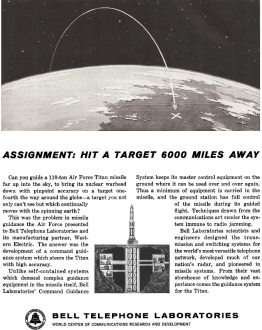|
September 1960 Electronics World
 Table of Contents
Table of Contents
Wax nostalgic about and learn from the history of early electronics. See articles
from
Electronics World, published May 1959
- December 1971. All copyrights hereby acknowledged.
|
Until seeing this Bell
Telephone Laboratories promotion in a 1960 issue of Electronics World
magazine, I never considered that programming an autonomous missile for long
distances and long flight times in the days before GPS required compensation for
the Earth's rotation. Also, even though an intercontinental ballistic missile (ICBM)
would spend a relatively small amount of time in the atmosphere during boost and
reentry / terminal phases, wind effects would also need to be factored in to the
onboard inertial guidance system's navigation program. Bell Labs was evidently
tasked to design a system which could launch from the U.S. and fly to a target
6,000 miles away, and hit a designated spot closely enough to do the intended
damage. According to the online
great circle
distance calculator, the trajectory from Lincoln, Nebraska, to Moscow,
Russia (USSR in 1960)
is 5,258 miles, so it is reasonable to assume the chore had similar start / stop
locations in mind.
Bell Telephone Laboratories Ad
 Assignment:
Hit a Target 6000 Miles Away
Assignment:
Hit a Target 6000 Miles Away
Can you guide a 110-ton Air Force Titan missile far up into the sky, to bring
its nuclear warhead down with pinpoint accuracy on a target one-fourth the way around
the globe - a target you not only can't see but which continually moves with the
spinning earth?
This was the problem in missile guidance the Air Force presented to Bell Telephone
Laboratories and its manufacturing partner, Western Electric. The answer was the
development of a command guidance system which steers the Titan with high accuracy.
Unlike self-contained systems which demand complex guidance equipment in the
missile itself, Bell Laboratories' Command Guidance System keeps its master control
equipment on the ground where it can be used over and over again. Thus a minimum
of equipment is carried in the missile, and the ground station has full control
of the missile during its guided flight. Techniques drawn from the communications
art render the system immune to radio jamming.
Bell Laboratories scientists and engineers designed the transmission and switching
systems for the world's most versatile telephone network, developed much of our
nation's radar, and pioneered in missile systems. From their vast storehouse of
knowledge and experience comes the guidance system for the Titan.
Bell Telephone Laboratories
World Center of Communications Research and Development
Posted August 26, 2021










